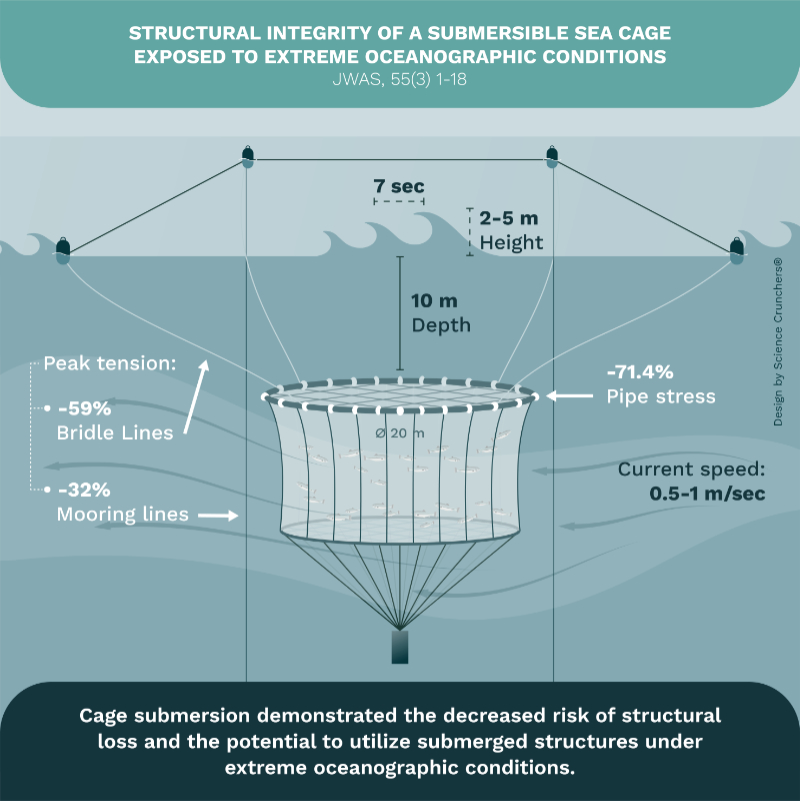JWAS Editor's Choice Awards 56(1)
The use of integrated multi-trophic aquaculture (IMTA) for multi-species culture is not new, but thi...

Successful aquaculture expansion into open ocean environments will require structures that can withstand extreme conditions found off the coast of Chile and many other countries. This study utilized a dynamic simulation model to assess the structural integrity of a submersible cage with dimensions of 20 m diameter x 10 m depth. The simulation tested current speeds of 0.5 and 1 m/s and wave heights ranging from 2 to 5 m and a period of 7 s. Evaluating stresses on the cage´s pipes and tension in the bridle and mooring lines, it was found that submerging the cage leads to a 71.4% decrease in stress on pipes and a decrease in peak tensions of 32% for mooring lines and 59% for bridle lines. Such reductions following the submersion of cages demonstrate the decreased risk of structural loss and the potential to utilize submerged structures under extreme oceanographic conditions.
China is the largest producer of cultured pearls with freshwater pearls accounting for over 95% of this production. This study determined the effects of feeding different ratios of two algae strains (Scenedesmus dimorphus and Cyclotella sp.) on the freshwater mussel Hyriopsis cumingii. The authors compared growth, peal production ability, and various shell tissue properties following feeding. It was found that mixed feeding at different densities resulted in significant changes in growth, bead production quality, trace elements, and the composition of amino acids in newly formed shell tissue. Furthermore, body weight and shell growth rate were elevated when feeding 30 x 105 cells/ml of S. dimorphus and 8 x 105 cells/ml of Cyclotella sp. Pearl weight gain, amino acid ratio, and Ca2+ and Mn2+ were highest when feeding 16 × 105 cell/mL of Cyclotella sp, but this finding was similar to the above treatment. Therefore, it was concluded that the optimal ratio for intensive culture of H. cumingii is to provide a mixed feeding of S. dimorphus (30 × 105 cell/ml) and Cyclotella sp. (8 × 105 cell/ml). This is one of the first reports on the effects of feeding different ratios of microalgae on pearl production and growth of H. cumingii.
Extensive culture and breeding of the Chinese mitten crab (Eriocheir sinensis) occur in Northern and Eastern China; however, frequent disease and germplasm degradation have impacted sustainable aquaculture development of this species. The effect of supplementing crustacean feed with the unicellular algae Haematococcus pluviali was determined in this study. The authors explored growth, antioxidantase activity, and gut microbiota changes in this species following supplementation with 5% H. pluvialis powder. It was found that groups of crabs fed H. pluvialis powder had significantly improved weight gain and specific growth rate (p < 0.05) following 14 days of feeding. Superoxide dismutase (SOD) and catalase (CAT) were found to decline, while the activity of phenoloxidase (PO) rose following treatment with H. pluvialis powder. Alkaline phosphatase (AKP) activity initially decreased then increased. The authors found that there were significant changes in dominant bacterial phyla in the gut with the relative abundance of Firmicutes and Candidatus_Bacilloplasma being higher in treated crabs. Taken as a whole, this study recommended that supplementation with 5% H. pluvialis powder may provide rapid fattening and potentially improve immunity and metabolic capacity of E. sinensis.